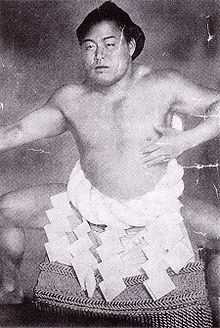Tochigiyama Moriya
| Tochigiyama Moriya | |
|---|---|
| 栃木山守也 | |
 | |
| Personal information | |
| Born |
横田 (中田) 守也 Yokoda (Nakata) Moriya February 2, 1892 Tochigi, Japan |
| Died | October 3, 1959 (aged 67) |
| Height | 1.72 m (5 ft 7 1⁄2 in) |
| Weight | 104 kg (229 lb; 16.4 st) |
| Career | |
| Stable | Dewanoumi |
| Record |
197-26-24 7draws-5holds (Total) 166-23-24 7draws-4holds (Makuuchi) |
| Debut | February, 1911 |
| Highest rank | Yokozuna (February, 1918) |
| Retired | May, 1925 |
| Championships |
9 (Makuuchi) 1 (Makushita) |
| Gold Stars | 2 (Ōtori) |
| * Up to date as of September 2007. | |
Tochigiyama Moriya (栃木山 守也, February 2, 1892 – October 3, 1959) was the 27th yokozuna in sumo wrestling from 1918 until 1925. Generally he is considered one of the pioneers of modern sumo.[1] He is the lightest yokozuna with a weight of 104 kg.[2]
Early career
Tochigiyama entered sumo in February 1911 but his coach Hitachiyama Taniemon didn't expect him to be strong owing to his light weight. However, he lost only 3 bouts on his way to the top makuuchi division, achieving promotion in January 1915. Tochigiyama defeated Tachiyama Mineemon, ending his series of 56 victories, on the 8th day of May 1916 tournament.
Tochigiyama was promoted to ōzeki in May 1917. After he won both championships on his two tournaments as ōzeki without suffering a single defeat, he was promoted to yokozuna in February 1918.
Yokozuna
Tochigiyama won his third championship at his first tournament as yokozuna. He also won the following two tournaments. He would go on to achieve five consecutive championships between May 1917 and May 1919.
Tochigiyama defeated other wrestlers with his strong oshi, or pushing techniques. He compensated for his lack of weight by training extremely hard. He was nicknamed the "little giant yokozuna".[3] Like Hitachiyama before him, he trained many wrestlers, such as later yokozuna Tamanishiki San'emon, even though they were not members of the Dewanoumi stable.
In May 1925, he suddenly retired after winning three consecutive championships between January 1924 and January 1925. Asked about his retirement, he stated that he wanted to retire while still a strong opponent.
Tochigiyama only lost 23 times while an active sumo wrestler in the top makuuchi division, and only eight times during his seven years in the yokozuna rank. His top division winning percentage was 87.8. In addition, his winning percentage as yokozuna reached 93.5, the fourth best in history after Jinmaku, Tachiyama and Tanikaze.[2][4]
Retirement from sumo
After his retirement, he was permitted to leave Dewanoumi stable and become the eighth head coach of Kasugano stable. He was the adopted son of the previous head coach, referee Kimura Soshiro. IN his tenure, Tochigiyama produced yokozuna Tochinishiki Kiyotaka.
In June 1931, Tochigiyama took part in the first Dai-Nippon Rikishi Senshuken (大日本角力選手権), special sumo tournament. To the surprise of many, he defeated Tamanishiki and Tenryū, and won the championship.[3] In the modern age, retired wrestlers can no longer take part in any special sumo tournaments.
In 1952 he performed his kanreki dohyō-iri or '60th year ring entrance ceremony' to commemorate his years as yokozuna. His strength hardly declined long into his retirement. It is reported that Tochigiyama in his sixties easily carried a large hibachi which none of his other junior stable members could move.
He died suddenly in 1959 whilst still in charge of Kasugano stable. Tochinishiki, who Tochigiyama had in turn adopted as his son, was his successor.
Career record
| - | Spring | Summer | ||||
|---|---|---|---|---|---|---|
| 1911 | (Maezumo) | Jonokuchi #29
5–0 |
||||
| 1912 | Jonidan #37
5–0 |
Sandanme #46
3–0 1h |
||||
| 1913 | East Makushita #49
5–0 Champion |
Makushita #11
4–1 |
||||
| 1914 | West Jūryō #10
4–1 |
East Jūryō #4
4–1 |
||||
| 1915 | East Maegashira #16
8–2 |
East Maegashira #2
5–4 1d ★ |
||||
| 1916 | East Maegashira #1
7–3 ★ |
East Komusubi
6–3–1 |
||||
| 1917 | West Sekiwake
6–3–1 |
West Ōzeki
9–0 1h |
||||
| 1918 | East Ōzeki
10–0 |
East Yokozuna
9–1 |
||||
| 1919 | East Yokozuna
9–0–1 |
East Yokozuna
10–0 |
||||
| 1920 | East Yokozuna
8–2 |
West Yokozuna
8–0 1d 1h |
||||
| 1921 | West Yokozuna
9–0 1h |
East Yokozuna
9–1 |
||||
| 1922 | East Yokozuna
8–1 1h |
West Yokozuna
7–1–1 1d |
||||
| 1923 | East Yokozuna
8–1 1d |
West Yokozuna
1–0–9 1h |
||||
| 1924 | West Yokozuna
9–0 1d |
East Yokozuna
10–1 |
||||
| 1925 | East Yokozuna
10–0 1d |
West Yokozuna
Retired 0–0–11 |
||||
| Record given as win-loss-absent Top Division Champion Retired Lower Divisions Key: ★=Kinboshi(s); d=Draw(s) (引分); h=Hold(s) (預り) | ||||||
See also
- Glossary of sumo terms
- Kanreki dohyō-iri
- List of past sumo wrestlers
- List of sumo tournament top division champions
- List of yokozuna
References
- ↑ 人物「明治時代以降」栃木山守也 (in Japanese). Tochigi Prefecture. Retrieved 2008-05-25.
- ↑ 2.0 2.1 "Complete List of Yokozuna". Sumo Colosseum. Retrieved 2008-07-03.
- ↑ 3.0 3.1 3横綱生んだ本県 (in Japanese). Yomiuri Shimbun. Retrieved 2008-07-04.
- ↑ Kuroda, Joe (February 2006). "A Shot At the Impossible-Yokozuna Comparison Through The Ages". sumofanmag.com. Retrieved 2008-07-03.
- ↑ "Tochigayama Moriya Rikishi Information". Sumo Reference. Retrieved 2013-06-11.
External links
- (Japanese)Tochigiyama Moriya
| Previous: Ōnishiki Uichirō |
27th Yokozuna February 1918 - May 1925 |
Next: Ōnishiki Daigorō |
| Yokozuna is not a successive rank, and more than one wrestler can share the title | ||